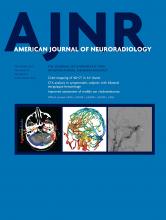Table of Contents
Perspectives
General Contents
- Altered Relationship between Working Memory and Brain Microstructure after Mild Traumatic Brain Injury
The authors investigated how working memory deficits relate to detectable WM microstructural injuries to discover robust biomarkers that allow early identification of patients with mild traumatic brain injury at the highest risk of working memory impairment. Multi-shell diffusion MR imaging was performed on a 3T scanner with 5 b-values. Diffusion metrics of fractional anisotropy, diffusivity and kurtosis (mean, radial, axial), and WM tract integrity were calculated. Auditory-verbal working memory was assessed using the Wechsler Adult Intelligence Scale. ROI analysis found a significant positive correlation between axial kurtosis and Digit Span Backward in mild traumatic brain injury mainly present in the right superior longitudinal fasciculus, which was not observed in healthy controls.
- Color-Mapping of 4D-CTA for the Detection of Cranial Arteriovenous Shunts
A color-mapping method for 4D-CTA is presented for improved and enhanced visualization of the cerebral vasculature hemodynamics. This method was applied to detect cranial AVFs. Thirty-one patients were included, 21 patients with and 10 without an AVF. Arterialization of venous structures in AVFs was accurately visualized using color-mapping. There was high sensitivity (86%–100%) and moderate-to-high specificity (70%–100%) for the detection of AVFs on color-mapping 4D-CTA, even without the availability of dynamic subtraction rendering. Arterialization of venous structures can be visualized using color-mapping of 4D-CTA and proves to be accurate for the detection of cranial AVFs.
- Automatic Spinal Cord Gray Matter Quantification: A Novel Approach
The authors assessed the reproducibility and accuracy of cervical spinal cord gray matter and white matter cross-sectional area measurements using magnetization inversion recovery acquisition images and a fully automatic postprocessing segmentation algorithm. The cervical spinal cord of 24 healthy subjects was scanned in a test-retest fashion on a 3T MR imaging system. Twelve axial averaged magnetization inversion recovery acquisition slices were acquired over a 48-mm cord segment. GM and WM were both manually segmented by 2 experienced readers and compared with an automatic variational segmentation algorithm with a shape prior modified for 3D data with a slice similarity prior. Reproducibility was high for both methods, while being better for the automatic approach. The accuracy of the automatic method compared with the manual reference standard was excellent. They conclude that the fully automated postprocessing segmentation algorithm demonstrated an accurate and reproducible spinal cord GM and WM segmentation.
- Comparative Analysis of Volumetric High-Resolution Heavily T2-Weighted MRI and Time-Resolved Contrast-Enhanced MRA in the Evaluation of Spinal Vascular Malformations
The authors compared the efficacy of volumetric high-resolution heavily T2-weighted and time-resolved contrast-enhanced images in spinal vascular malformation diagnosis and feeder characterization and assessed whether a combined evaluation improved the overall accuracy of diagnosis in 28 patients. Both sequences demonstrated 100% sensitivity and 93.5% accuracy for the detection of spinal vascular malformations. Volumetric high-resolution heavily T2-weighted imaging was superior to time-resolved contrast-enhanced MR imaging for identification of spinal cord arteriovenous malformations while the opposite was observed for perimedullary arteriovenous fistulas. Both sequences showed equal sensitivity (100%) and accuracy (87%) for spinal dural arteriovenous fistulas. They conclude that combined volumetric high-resolution heavily T2-weighted imaging and time-resolved contrast-enhanced MR imaging can improve the sensitivity and accuracy of spinal vascular malformation diagnosis, classification, and feeder characterization.



